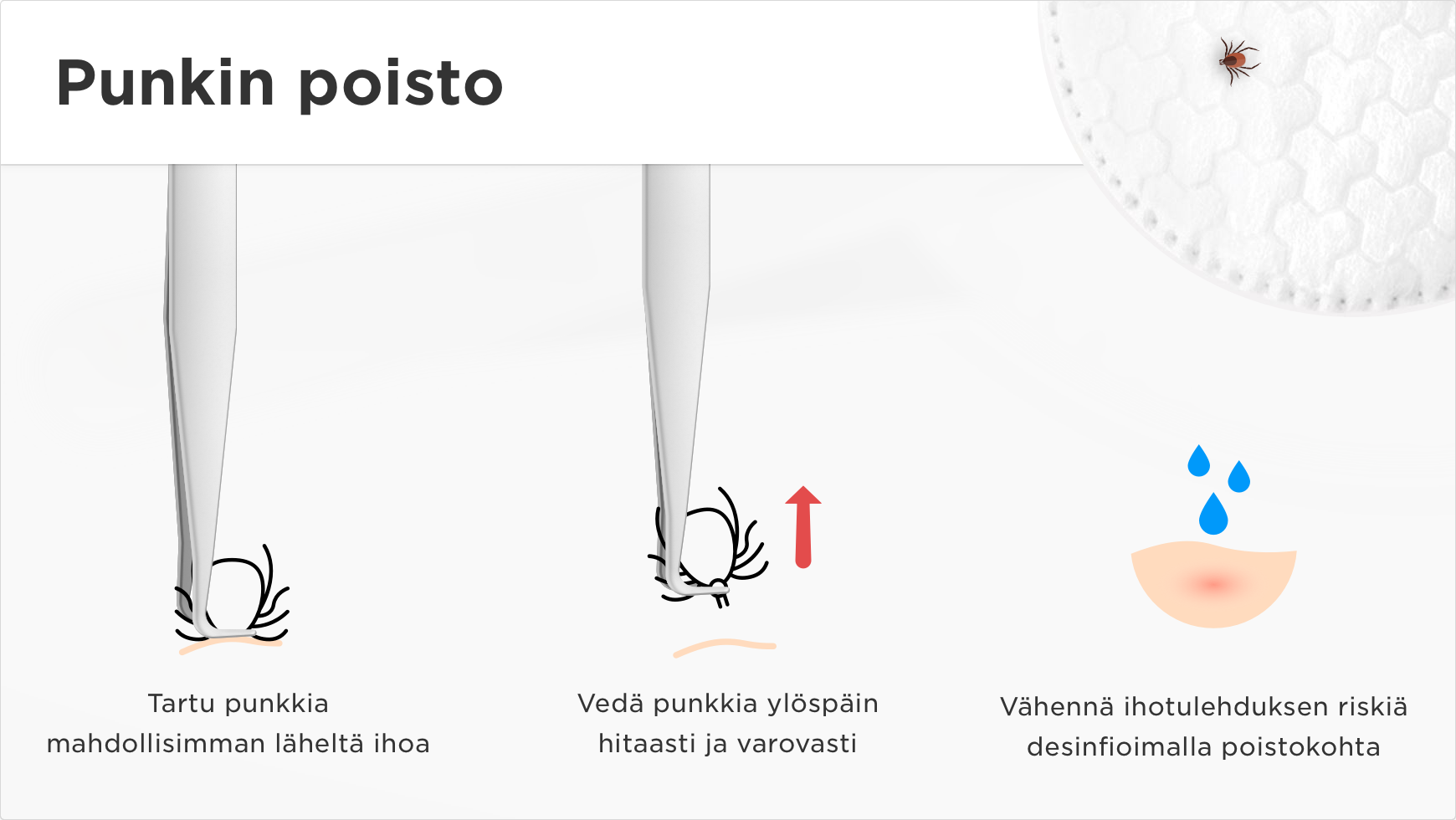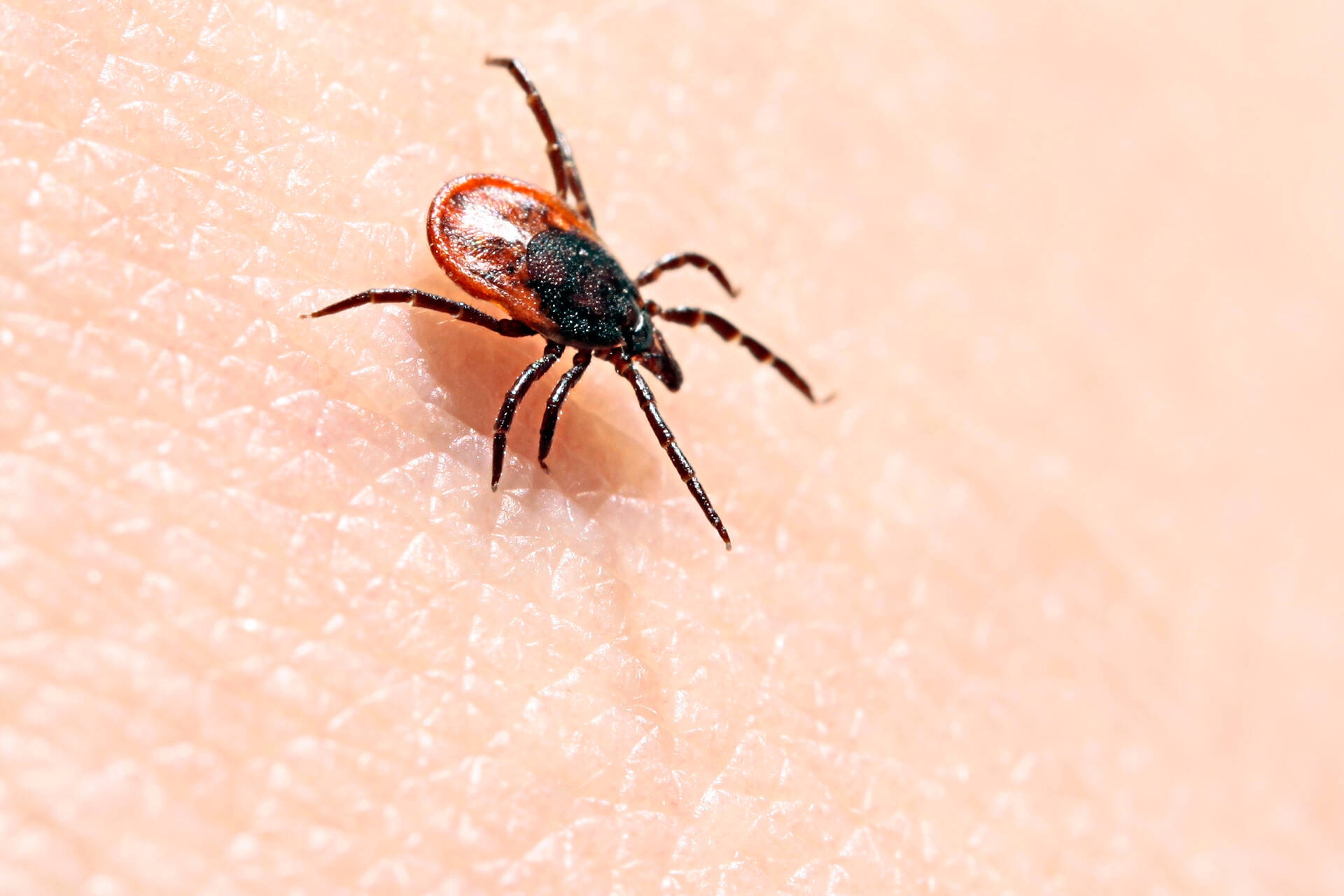
Tick bite – what to do if a tick bites
Specialist in the article

Revised 3/1/2025
Ticks and tick bites in brief
- Ticks spread diseases, the most common of which are Lyme disease and tick-borne encephalitis (TBE), against which you can protect yourself with a TBE vaccine.
- The best way to prevent tick bites is to wear protective clothing, carry out regular tick checks and use an insect repellent that works on ticks.
- Remove the tick with a tick lasso or tweezers by slowly pulling upwards close to the skin. Clean the bite area with disinfectant.
- A rapid removal of ticks significantly reduces the risk of developing Lyme disease, and the TBE vaccine prevents approximately 90% of tick-borne encephalitis infections.
Tick bite prevention
Tick bites are best prevented by wearing protective clothes and performing tick bite inspections regularly. When walking in a natural environment, it is a good idea to wear high boots, long-sleeved trousers and a long-sleeved shirt and to wear your socks over the trouser legs. Wearing light-coloured clothing makes it easier to detect ticks.
Regular tick checks
Tick checks should be made at least once a day. If you move outdoors a lot, you should perform the check a couple of times a day. The risk of a tick infection is significantly smaller if the tick is detected at an early stage. In a tick inspection, it is advisable to carefully examine the bends of your arms and feet and behind your ears. It is also a good idea to run your fingers through your scalp.
Tick bites may occur in warm autumns up to even November, so it is good to continue the checks after the summer season. Ticks may be transported indoors in the fur of pets and transferred to a person, so it is also worth performing a tick check after your pet has been outdoors.
However, tick-borne encephalitis may transmit immediately after the tick has burrowed itself into your skin within a couple of minutes and, in order to prevent it, a daily check is not enough. Anyone who moves in an area that involves the risk of tick-borne encephalitis is advised to get TBE vaccinated.
Learn more about the TBE vaccineTicks on the skin – what to do
Once a tick becomes attached to your skin, it must be removed as quickly as possible. The easiest way to remove a tick is to use a lasso-like instrument or a pair of thin tweezers in order to get a good grip of the tick as close to the skin as possible.
Tick removal:
- Grab the tick with a lasso-like instrument or a pair of thin tweezers as close to the skin as possible.
- The tick can be removed with a slow and careful upward pulling movement. Avoid twisting or squeezing the tick excessively.
- Once the tick has been removed, the area of the skin in which the tick was burrowed can be cleaned with a disinfectant. This procedure reduces the risk of a skin infection, but it has not been shown to have any effect in the prevention of the onset of Lyme disease.
In some cases, the tick��’s proboscis may remain in the skin. However, this usually does not cause any harm and the part of the tick left in the skin will be removed spontaneously over time.

Tick bite marks
Tick bite marks can vary, but they often look like a ring-shaped pattern with red borders and a light centre. Sometimes the bite mark may also be a uniform, reddish patch. Such expanding redness may indicate a Lyme disease infection and it is important to seek medical attention.
A tick bite mark may be difficult to detect or distinguish from other insect bites or stings if the tick has been removed from the skin. Anaesthetic substances are secreted with the tick’s saliva, which is why you cannot feel the "hooks" of the tick’s proboscis when the tick sucks blood.
Tick bite symptoms
Once the tick has been removed or a bite mark has been detected, the area of the skin should be monitored every few days to see if there are any symptoms. The easiest way to do so is to write down the date and location of the bite or to take a photo of the bite.
Once a tick burrows into the skin, a small red area is likely to appear, just like in the case of other insect bites. This reaction can be alleviated with an antihistamine like cetirizine, for example.
When should I see a doctor if I have been bitten?
You do not automatically need to see a doctor immediately due to a tick bite. Only a few percent of ticks spread the disease, so a bite does not automatically mean that you have been infected. A tick bite can also be initially assessed remotely at Digital Clinic.
You should see a doctor if you experience the following after a tick bite:
- Spreading rash: A rash accompanied by a circular or an even flush with a diameter of at least 5 cm from the bite area begins to develop on the skin. In this case, Lyme disease is suspected.
- Lymphocytoma: A red or blue soft lymphocytoma, a benign tumour, appears on the skin.
- Cold-like symptoms: Approximately 7–28 days after a tick bite, you will experience cold-like and vague symptoms. These may be symptoms of tick-borne encephalitis (TBE).
- Nervous system symptoms: You suffer from a severe headache, neck stiffness or neurological symptoms such as balance disorders, convulsions or symptoms of paralysis.
Information about ticks and diseases caused by ticks
A tick is a small arthropod which belongs to the arachnids. Approximately 1,500 species of ticks have been found in Finland. Among the tick species, Ixodes ricinus and Ixodes persulcatus spread diseases, the most common of which are:
- Lyme disease. A disease caused by Borrelia bacteria. The onset of the “wandering flush” (erythema migrans) associated with Lyme disease only occurs several days, weeks or even months after the tick bite.
- Tick-borne encephalitis, or TBE virus. A virus-induced disease that typically has two phases. The vague and cold-like symptoms of the first phase begin approximately 7 and 28 days after the tick bite, after which the symptoms pass. One third of patients then develop nervous system symptoms, such as a headache, neck stiffness or balance problems.
Life stages of ticks
A tick lives for about 2–4 years and has three stages of development: larva, nymph and adult. The tick eats blood so that it can progress to the next stage. The tick is 1–5 mm in size at different stages of development, but if it ingests blood, it can swell up to 10 mm.
Habitat of ticks
Ticks occur particularly in the southern archipelago and coastal areas. However, you can get a tick bite on a lakeside and along the coast of the North Gulf of Bothnia, all the way to Lapland.
Ticks start to move in the spring when the temperature rises above 5°C. Depending on the temperature, they can be on the move from April–May to October–November. Ticks usually thrive in humid environments with lots of vegetation. Such terrain includes, for example, bogs, field edges, tall grass and bushes.
You can find doctor-specific prices in our appointment booking in the doctor's information.
| Service | Price estimate |
|---|---|
| Appointment, 20 min Price per appointment. | from 71,80 € Without Kela reimbursement from 101,80 € |
| Consultation visit, 30 min Price per visit. | from 101,80 € Without Kela reimbursement from 131,80 € |
| Consultation visit, 45 min Price per visit. | from 138,80 € Without Kela reimbursement from 168,80 € |
Frequently asked questions about tick bites
Tick bite marks can vary, but they often look like a ring-shaped pattern with red borders and a light centre. Sometimes the bite mark may also be a uniform, reddish patch. Such expanding redness may indicate Lyme disease infection, so it is important to see a doctor and treat the infection early with antibiotics.
Tick bite areas can be red, just like other insect bites and stings. A rash that indicates Lyme disease caused by tick bite spreads circularly or develops an even red area from the bite and grows to over five centimetres.
Tick bites can be red and itchy, just like other insect bites and stings. This reaction can be alleviated with an antihistamine like cetirizine, for example.
A tick bite is usually not painful. Anaesthetic substances are secreted with the tick’s saliva, which is why you cannot feel the "hooks" of the tick’s proboscis when the tick sucks blood. As a result, it may be difficult to detect or distinguish a tick bite from other insect bites if the tick has been detached from the skin.
Tick bites can be dangerous due to diseases spread by ticks. However, a tick bite does not automatically mean that you will become sick, as not all ticks carry the tick-borne encephalitis virus or the Borrelia bacteria. A rapid removal of ticks also significantly reduces the risk of developing Lyme disease, and the TBE vaccine prevents approximately 90% of tick-borne encephalitis infections.
You don't need to see a doctor right away if you get a tick bite, as only a small number of ticks spread disease. A doctor should be consulted if the following occurs after a bite:
- Spreading rash: A ring-shaped or evenly red rash that grows to over 5 cm in size.
- Lymphocytoma: A red or blue soft benign tumour on the skin.
- Cold-like symptoms: After approximately 7–28 days, the bite will cause cold-like symptoms.
- Nervous system symptoms: A severe headache, neck stiffness or neurological symptoms such as balance disorders or symptoms of paralysis.
The situation can also be initially assessed at Mehiläinen Digital Clinic.


